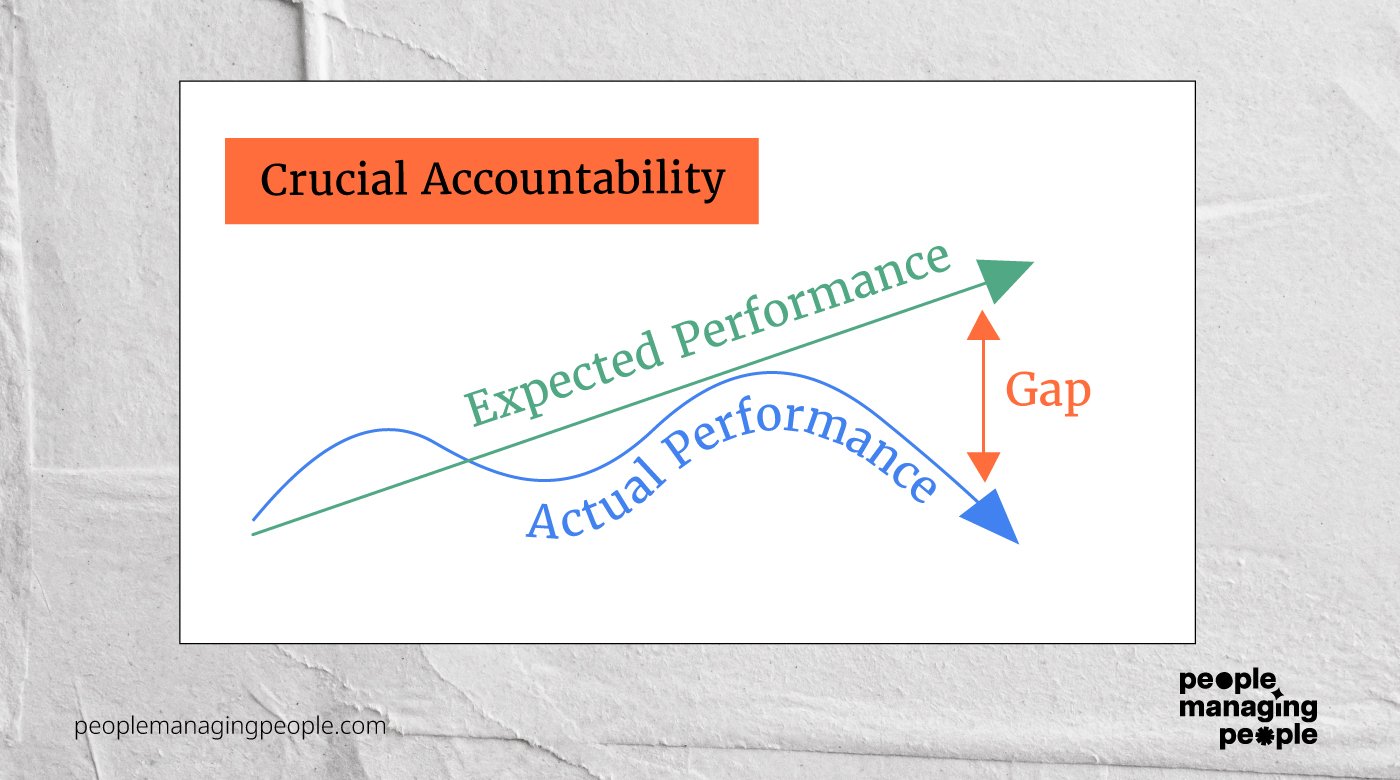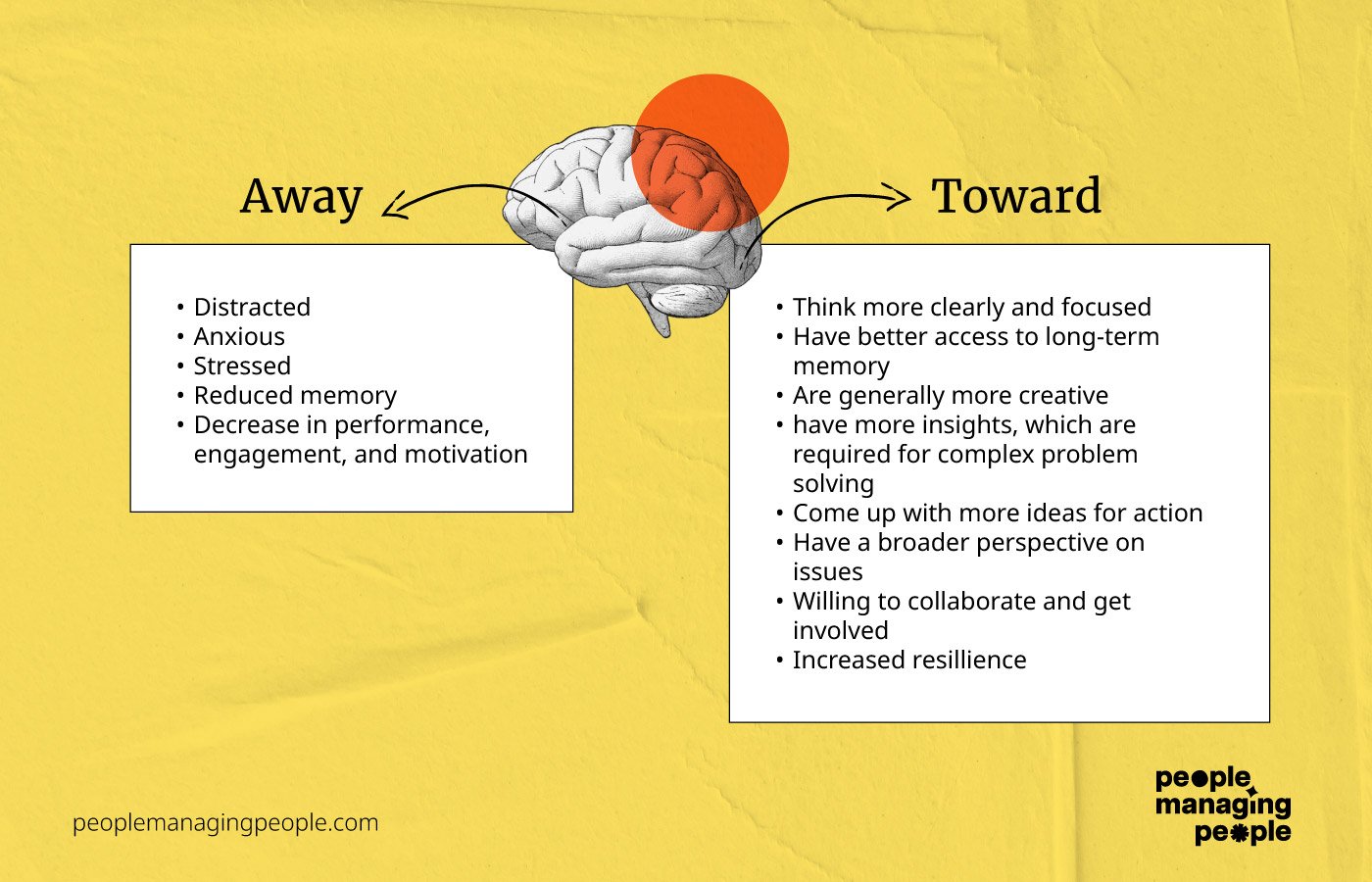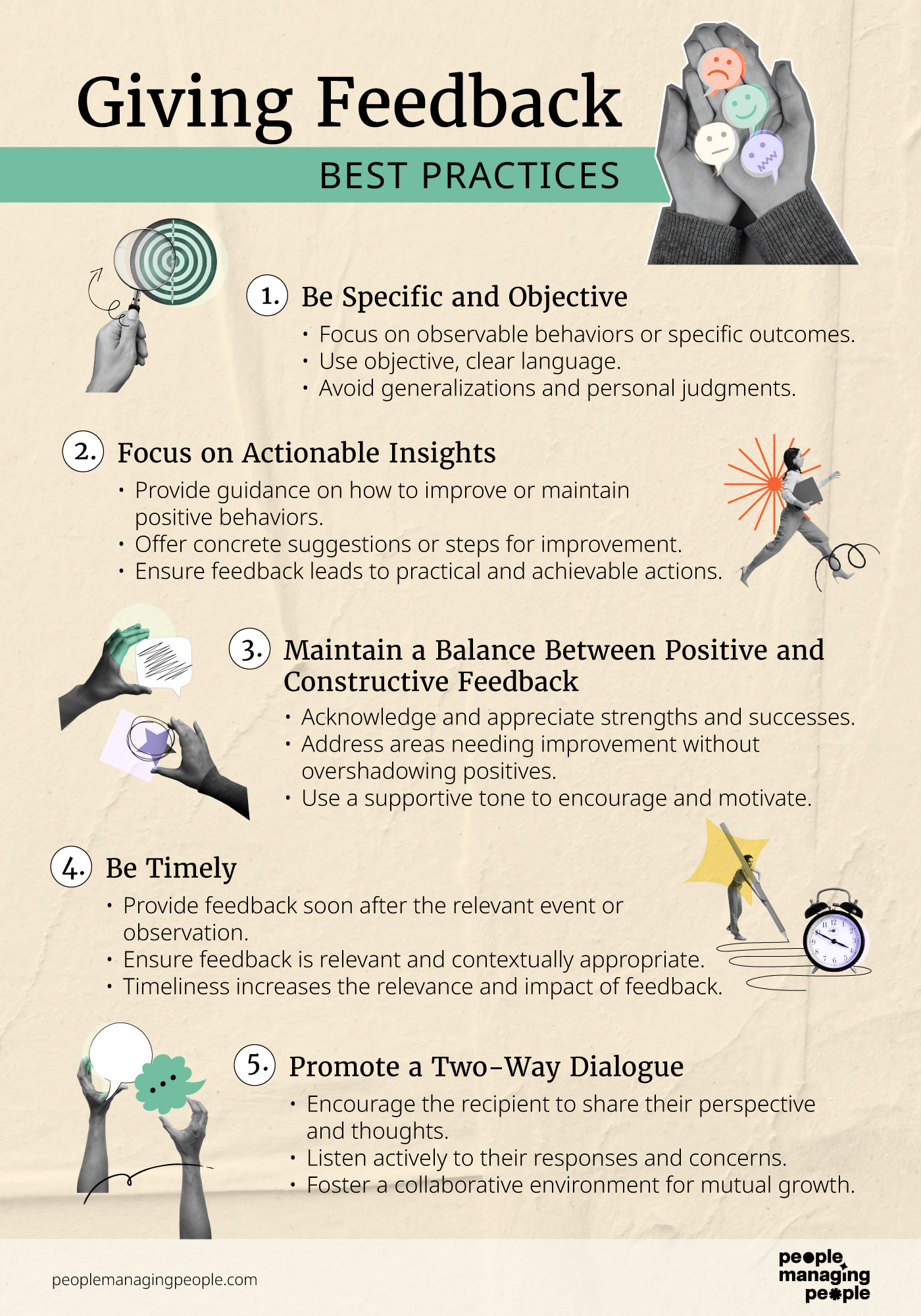The proof is in the pudding. Most managers don’t know how to give feedback effectively.
A survey conducted by Interact found that 69% of managers are uncomfortable communicating with employees, while 37% responded that they’re uncomfortable giving direct feedback about employee performance.
Whether you’re giving live feedback in a face-to-face meeting or setting up your teams to give asynchronous feedback through an employee survey tool, communicating around performance is a vital component of how leaders drive organizational success.
5 Ways to Give Feedback
Effective feedback is a cornerstone of personal and professional growth. It fosters improvement, encourages communication, and builds trust. However, the way feedback is delivered is as crucial as the feedback itself.
We're going to look at 5 techniques that enhance the impact of your feedback. Whether you're a manager, a peer, or a mentor, these strategies are designed to ensure that your feedback is constructive, empathetic, and empowering.
- Have Difficult Conversations ASAP
- Capture Goals, Expectations and Feedback in Writing
- Remove Ambiguity
- Leverage the Science of the Brain
- Foster Continuous Feedback
1. Have Difficult Conversations ASAP
Although our brains are wired to avoid conflict, honesty and accountability is the only way to effectively communicate with employees.
Everyone loves to hear positive feedback, but it can feel emotionally fraught to sit down with a team member and tell them where they’re falling short. Likewise, no one wants to receive negative feedback either.
The art of constructive criticism
In my experience coaching managers and leaders, I’ve found that most managers are resistant to having difficult conversations because they don’t want people to “feel bad” and worry they’ll respond negatively to critical feedback.
Consequently, managers don’t address their concerns directly with a team member. By the time they come to me for help, the underperformance has reached such a dire state that they feel there is no pathway to get back on track.
Actionable Advice
Here are some tips to ensure your criticism is well received and impactful.
- Make feedback timely - Don't wait until they've moved on to something else or have created bad habits.
- Frame the conversation around their success - Building up the potential of the employee and their work is more effective than harping on their mistakes and making them feel insecure.
- Be direct and clear - A mealy-mouthed approach can confuse employees further and ensure your message is lost. To the point with a focus on clarity is always better.
- Approach the employee with empathy - You simply don't know what someone is dealing with outside of work. Remember, this is a human being who may be struggling with relationships or health issues, mental or physical.
According to Gallup, 98% of employees will fail to be engaged if their manager gives them little or no feedback. Therefore, effective feedback is crucial for driving high performance and employee engagement.
2. Capture All Goals, Expectations, And Feedback In Writing
The number one way to remove ambiguity from expectations is to write them down somewhere easily accessible by all parties. This applies not only to feedback but overall goals and expectations for team members.
It’s best practice for managers to have regularly scheduled 1:1s with each of their direct reports, ideally on a weekly basis. My suggestion is to use a 1:1 template that is updated in advance of the recurring meeting to keep all parties aligned and on track.
Benefits of a Template
Using a 1:1 meeting template helps organize the conversation, clarify priorities, and track progress against goals over time. It’s also an excellent way to prepare a direct report for an upcoming feedback conversation.
There are times managers will need to meet separately with a team member to debrief an incident or have a formal performance discussion.
Here’s how to approach this kind of conversation:
- Organize the feedback into at least 3, but no more than 5, themes with supporting examples of each area of underperformance or behavior to address.
- State the impact this underperformance or specific behavior has on customers, stakeholders and fellow co-workers.
- Be specific as possible, with specific examples of what you have observed, and what you would like to see instead.
- Solicit input from the employee, including their suggestions on how things can be improved and what commitments they can make going forward.
- Affirm your support for the employee, that your goal is to make them successful and that you are there to provide resources and guidance along the way.
- Establish next steps, providing takeaways and action items that are clear to both parties.
Actionable Advice
When having a more formal conversation, be sure to follow up with a written summary via email.
I like to use a script starting with: “I’d like to recap our conversation today by summarizing what we discussed and what steps we will take moving forward.”
This confirms alignment between manager and team member and provides a reference to look back on.
3. Remove Ambiguity: Address Underperformance By Identifying The Gap
In some roles, it’s easy to identify areas of underperformance. For example, a salesperson is either meeting their quota or not. But what if results and overall performance are less tangible, such as in a role like finance or HR?
It can be a challenge for managers to describe exactly what is not going right for one of their direct reports in these areas, especially when it involves soft skills. But specificity and clarity are crucial for improvement.
Actionable Advice
The Crucial Accountability Model offers a straightforward approach to overcoming this challenge:
- Describe the expectation
- Describe what you are observing that differs from expectation
- The space therein is referred to as “the gap”.
The conversation to follow should center around what the employee must do to close that gap.
Do they need additional resources or guidance? Is it a matter of upskilling?
In order to support the employee in fully meeting expectations, the picture of what success looks like must be clear for them.

4. Leverage The Science Of The Brain
David Rock, founder of the NeuroLeadership institute, introduced the SCARF model as a reference tool for collaborating with others, including giving and receiving feedback.
The idea is simple: if the brain perceives what you're about to say as a social threat, it will move into an “Away state”, i.e. a type of fight or flight mindset, and prevent the employee from processing what you’re about to tell them.
According to the SCARF model, the 5 domains that can be most socially triggering are:
- Status – our relative importance to others. Example: “Am I valued? Does my opinion matter?”
- Certainty – ability to see what lies ahead. next. Example: “What does the future hold for my role or for the company?”
- Autonomy – our sense of control over events. Example: “Am I given the tools to drive my own outcome? Am I able to make my own decisions?”
- Relatedness – how safe we feel with others. Example: “Can I trust those around me? Am I a part of the team?”
- Fairness – Perception of equitable treatment. Example: “Am I treated the same as my colleagues?”
If a negative response triggers the brain into an “Away state”, the employee will be distracted, unsettled, and likely won’t remember much of what you tell them next.
Actionable Advice
The goal is to approach the conversation and frame the feedback so the employee’s brain goes to a “Toward state”. Now the brain is able to think clearly, receive insights and problem solve.
A few suggestions on creating a Toward state for feedback:
- Provide a heads up and a clear agenda in advance of the meeting
- The feedback session should be held face-to-face (or over Zoom) so that the employee can see the manager’s body language and facial expression
- Ask the employee if it’s a good time to have a feedback conversation
- Approach the conversation from a perspective of how you can support
- Provide positive feedback as well, let the employee know what they’re doing well.

5. Foster A Culture Of Continuous Feedback And Celebrate Wins
A continuous feedback culture means that feedback does not begin and end with performance reviews. It means that leaders and employees alike ask for feedback on an ongoing basis, and the organizational culture is such that it’s the norm to discuss feedback frequently.
This means coaching your leaders to ask for regular feedback from their reports. The benefits of this strategy are many:
- Creates an environment of trust
- Allows for proactive addressing of areas of concern
- Improves the communication skills of both managers and team members
- Empowers employees to take charge of their own development by being able to address challenges.
Actionable Advice
Working toward a culture of continuous feedback needn’t be a big, formal initiative. It starts with your leaders giving and asking for feedback on a regular basis. At my current company, we practice this in the following ways:
- Encourage managers to recognize and reward employees for great work, both privately and publicly, using our Slack “shout-outs” channel.
- Coach managers on asking for feedback regularly and thanking team members when it’s given
- Provide a section of performance reviews dedicated to manager feedback.
- Schedule frequent check-ins between manager and direct report to keep communication open.
Use a Framework for Developing Your Feedback Process
Incorporating a structured framework into your feedback process can significantly enhance its effectiveness and clarity. Different models cater to varied contexts and needs. Let's explore some popular frameworks:
- The COIN Framework
COIN stands for Context, Observation, Impact, Next steps.
Example: In yesterday's meeting (Context), I noticed you interrupted several times (Observation). This seemed to disrupt the flow and others appeared hesitant to contribute (Impact). For future meetings, let's work on allowing everyone to finish their points (Next steps).
2. SBI (Situation-Behavior-Impact)
Focuses on specific Situation, observed Behavior, and its Impact.
Example: During the team workshop (Situation), you effectively resolved the technical issue (Behavior). This helped us stay on schedule and impressed the client (Impact).
3. STAR (Situation-Task-Action-Result)
Emphasizes the context of a Situation, as well as the Task, Action taken, and the Result achieved.
Example: In the quarterly sales meeting (Situation), your task was to present the new strategy (Task). Your thorough preparation and clear presentation (Action) led to the team's enthusiastic support and a clear action plan (Result).
4. Pendleton Model
Encourages self-assessment first, followed by positive feedback and suggestions for improvement.
Example: How do you think your presentation went? I believe you engaged the audience effectively (Positive feedback), but perhaps more data could be included next time (Suggestion).
5. BOOST (Balanced, Observed, Objective, Specific, Timely)
Ensures feedback is Balanced, based on Observed behavior, Objective, Specific, and Timely.
Example: I observed (Observed) in the last few project meetings (Timely) that your insights (Specific) are well-researched (Objective). Balancing this with more team interaction (Balanced) would be even more beneficial.
6. 360-Degree Feedback
Comprehensive feedback gathered from various sources like peers, subordinates, and supervisors.
Example: Your peers appreciate your teamwork, your juniors admire your leadership, and as your supervisor, I value your commitment. This 360-degree feedback indicates your strong team-building skills.
7. Stop-Start-Continue
A simple method stating what behaviors an employee should Stop, Start, and Continue.
Example: You should stop postponing the weekly reports, start contributing more in team discussions, and continue with your excellent client follow-ups.

Giving Feedback Best Practices
Providing effective feedback is an art that requires thoughtfulness and skill. Let's look at some best practices that can help make your feedback more impactful and constructive.
1. Be Specific and Objective
- Focus on observable behaviors or specific outcomes: Concentrate on actions and results that are directly observable, rather than subjective interpretations.
- Use objective, clear language: Avoid ambiguous terms and be precise in your descriptions.
- Avoid generalizations and personal judgments: Stick to the facts and steer clear of assumptions about personal traits or intentions.
2. Focus on Actionable Insights
- Provide guidance on how to improve or maintain positive behaviors: Offer clear, practical advice on what can be done differently or continued.
- Offer concrete suggestions or steps for improvement: Specific, actionable steps help in translating feedback into real change.
- Ensure feedback leads to practical and achievable actions: Set realistic expectations and achievable goals.
3. Maintain a Balance Between Positive and Constructive Feedback
- Acknowledge and appreciate strengths and successes: Recognition of good work fosters motivation and confidence.
- Address areas needing improvement without overshadowing positives: Ensure constructive feedback does not negate the recognition of successes.
- Use a supportive tone to encourage and motivate: A positive tone can enhance the acceptability and effectiveness of the feedback.
4. Be Timely
- Provide feedback soon after the relevant event or observation: Prompt feedback ensures that the details are fresh and more relatable.
- Ensure feedback is relevant and contextually appropriate: Align the feedback with the current circumstances and goals.
- Timeliness increases the relevance and impact of feedback: Immediate feedback is more likely to be seen as relevant and urgent.
5. Promote a Two-Way Dialogue
- Encourage the recipient to share their perspective and thoughts: This promotes understanding and shows respect for their viewpoint.
- Listen actively to their responses and concerns: Active listening demonstrates empathy and openness to dialogue.
- Foster a collaborative environment for mutual growth: Feedback is a two-way process and should be used as a tool for joint development.
Deliver the Right Feedback at the Right Time
Feedback is a critical part of performance management. Use the ideas presented here to equip leaders and managers in your organization to properly administer and ask for feedback.
This will allow your organization to get ahead of issues before they become unmanageable, while also driving higher performance and employee engagement.
In addition to creating a culture of continuous feedback, look to keep up with trends in peer-to-peer feedback and technology enhancements for creating a feedback loop.
And remember, feedback is a two-way street. Always be open to feedback from your team members about how you can improve as a manger, leader or organization in general.


